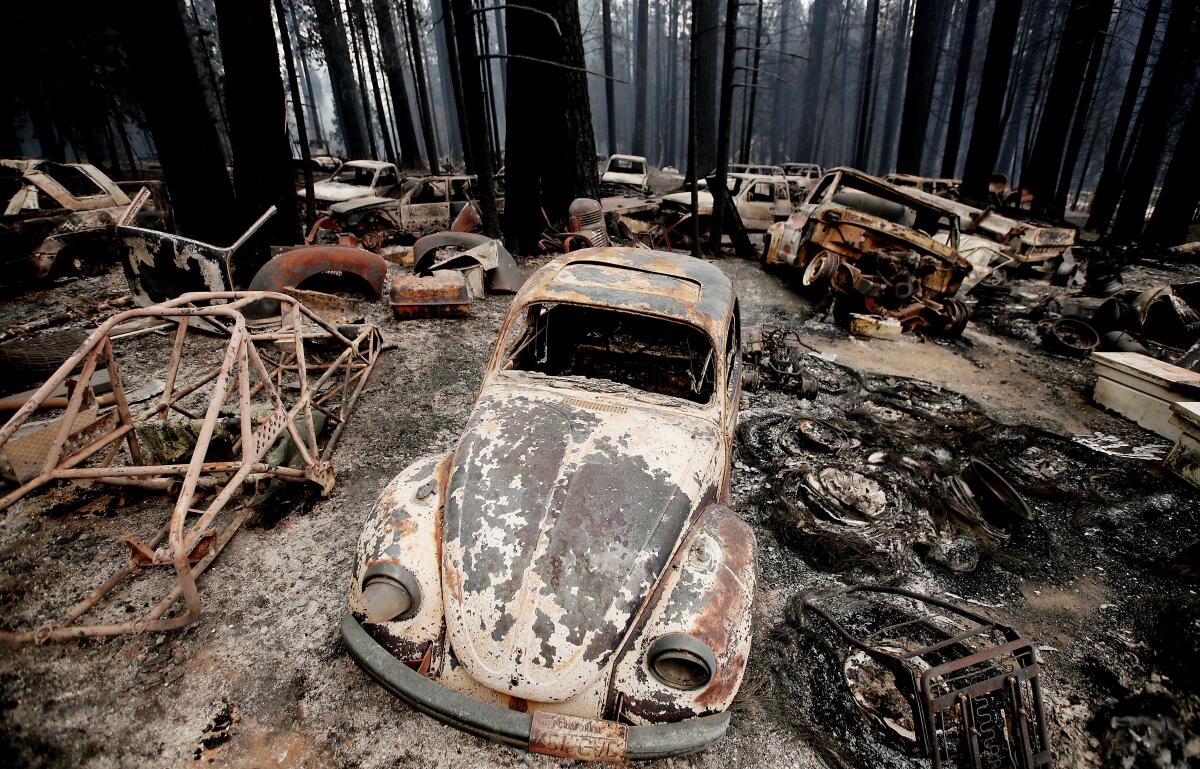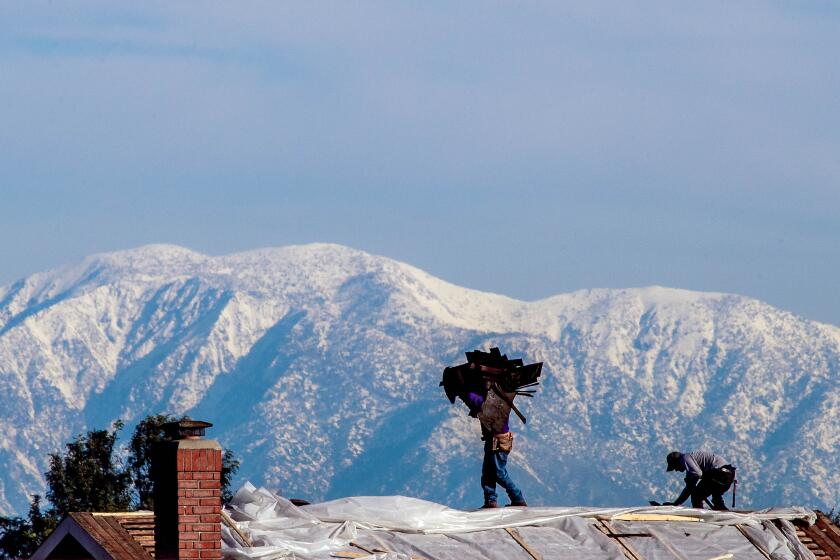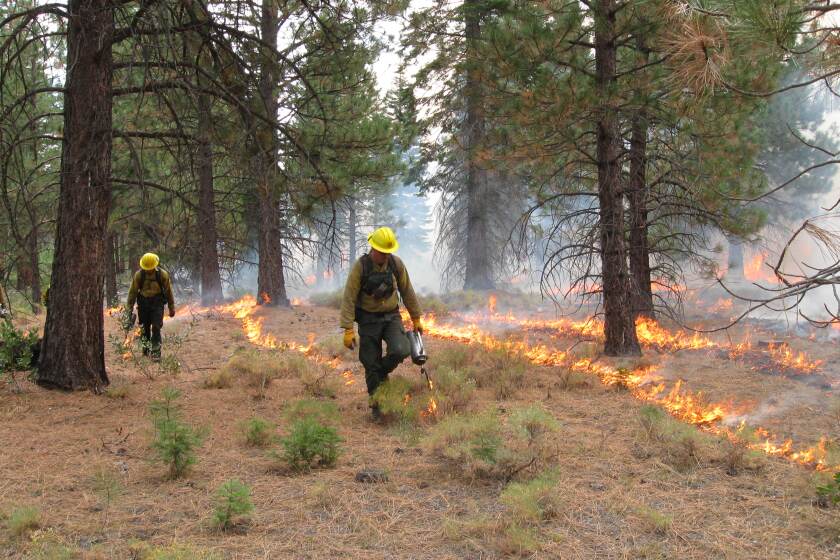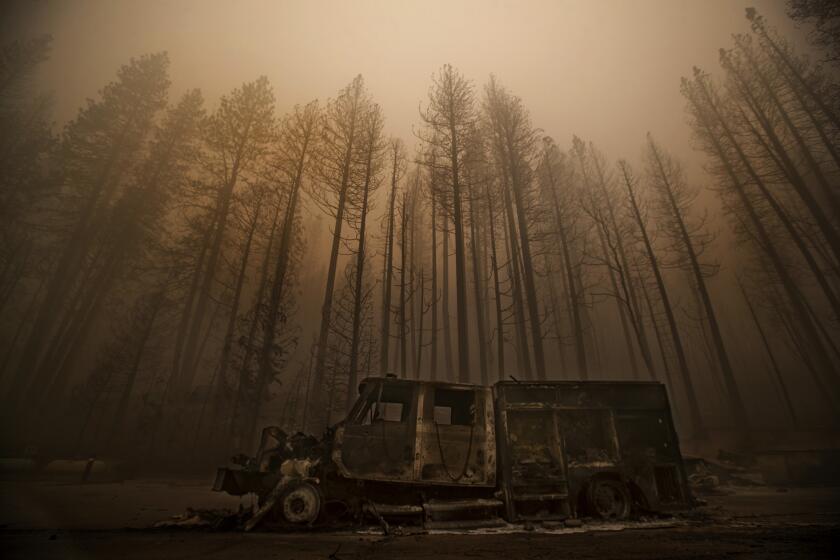Southern California spared major fires as storms end an unprecedented season

- Share via
The storms pounding California this week are expected to bring an end to a wildfire season that shocked fire crews with its unprecedented, climate-change-driven behavior.
For the first time ever, wildfires burned from one side of the Sierra Nevada to the other, destroying multiple towns including the Gold Rush-era community of Greenville and the mountain hamlet of Grizzly Flats.
Yet even despite that destruction, this fire season is poised to end with just three deaths — a circumstance that authorities attribute partly to the public’s willingness to heed precautionary evacuation orders and heightened awareness of the threat of wildfire.
A powerful storm that has already walloped Northern California could bring as much as 3 inches of rain to Southern California’s coastal areas.
Fires hit some regions of the state much harder than others. Although the Sierra was walloped, the Bay Area and Southern California saw a relatively tame year with few significant blazes.
“There were some large fires in the southern Sierra, but largely, coastal Southern California came through relatively unscathed,” said Nick Nauslar, predictive services meteorologist at the National Interagency Coordination Center.
The agency is forecasting that the southern portion of the state will see a reduced risk of large fires over the next couple of weeks due to below-normal temperatures and precipitation that’s near normal or a little above, which work together to hydrate vegetation. That comes after a series of October storms did the same for the rest of the state.
An upper-level ridge over the western United States that brought warm and dry conditions through November is also shifting to an upper-level trough, which brings cooler, wetter conditions, Nauslar said.
“The cooler the temperatures and the more precipitation there is, the higher the fuel moistures will get,” he said. “The higher the fuel moistures, the tougher it is for fire to ignite and spread.”
At the same time, Santa Ana wind events, which have driven some of the most damaging fires in Southern California, appear likely to occur at a below-normal frequency this winter, Nauslar said.
The weather shift, which brought rain starting Monday, will enable the California Department of Forestry and Fire Protection to evaluate and adjust preparedness levels, said Battalion Chief Jon Heggie. Some units are on schedule to reduce staffing by the end of December, either laying off seasonal workers or reorganizing personnel to focus on different projects such as fuel reduction, he said.
Still, Heggie said it would be unwise to think the change will extinguish the state’s risk of large fires entirely.
“There is no end of fire season,” he said. “We have devastating fires year-round in California.”
Even as evidence mounts that prescribed burns are effective in reducing wildfire risk, the U.S. Forest Service and other agencies are falling behind.
Experts had warned at the outset that this fire season had the potential to be severe. The region continues to be gripped by a long-term drought. Vegetation and soils were historically dry in many areas. The Sierra Nevada snowpack, which is supposed to melt gradually in the spring and summer, was nearly gone by May. Meanwhile, climate change has sent global temperatures rising, resulting in record-breaking heat waves.
When the fast-moving Palisades fire burned more than 1,200 acres near Topanga State Park in mid-May, some feared the early-season blaze was a harbinger of things to come. California then experienced its hottest summer on record and its driest water year in a century, further stoking concerns. By July, more land had burned in the state than at the same point in 2020, which saw more than 4 million acres burn in total — more than any other year in recorded history. Even as late as September, the state appeared on pace to match the record.
Although California did not end up surpassing that grim milestone, fires scorched nearly 2.6 million acres this season, putting it in the No. 2 spot in terms of land burned.
“Obviously the year before was abhorrent, but this year was extremely bad as well,” Heggie said.
As the season progressed, authorities described instance after instance of extreme fire behavior that challenged the conceptions of what is normal. Fires burned from one side of the Sierra to the other for the first time — and then the second time — reducing several towns to rubble. High-intensity flames also tore through giant sequoia groves for the second year in a row, wiping out a chunk of the trees’ population.
But although Northern California saw multiple fires that burned more than 100,000 acres, including the 960,000-acre Dixie fire, the state’s second largest on record, Southern California did not. The largest there was the Alisal fire, which scorched 16,970 acres along the Gaviota coast in Santa Barbara County after it was sparked during a sundowner wind event in October.
Though it may seem counterintuitive, the reason for that partly has to do with the drought, Nauslar said. In Mediterranean climates, grasses and shrubs rely on rain to grow. Fire, in turn, often relies on the connectivity of these plants to carry flames from a human source — for instance, a road where a dragging car muffler generates sparks — to nearby shrublands and forests.
“Due to the prolonged drought, there hasn’t been as much fuel growth,” Nauslar said. “And when you have less fuel growth, there’s less continuous fuels and less fuels overall, which means it is tougher for fires to spread and burn more intensely.”
The same does not hold true for forested portions of Northern California, where large timber stores mean there’s plenty of fuel for a fire regardless of whether it rains, he said. Experts say those areas have been made even more susceptible to burning severely because they are overstocked due to the elimination of Indigenous burning practices, a history of aggressive logging and decades of fire suppression. Drought and climate change have further exacerbated the situation by killing thousands of trees.
“So now there’s a huge amount of available fuel throughout the western part of the United States including California,” Heggie said. “That, combined with longer, hotter summers and drier years, is what’s contributing to having the potential for larger, more devastating fires.”
Southern California’s relative good fortune this fire season is not likely to last forever, however.
“If you really wanted to concoct the worst-case scenario for Southern California fire, you’d have a very wet winter in one year followed by extremely hot conditions and very dry conditions the year after it,” UCLA climate scientist Daniel Swain said.
That’s exactly what’s expected to happen more frequently in a warming climate, with wet spells becoming shorter and wetter and background conditions growing hotter and drier the rest of the time, he said. That will probably increase the variability of fire seasons in the coastal southern portion of the state, he said.
“In Southern California, I would expect there to be these big swings where the worst fire years are probably going to get worse, but then there will be these reprieve years in between where it’s unremarkable in a good way, kind of like this year,” he said.
New study says climate change is essentially two-thirds to 88% responsible for the conditions driving wildfire woes in the western United States.
This year’s death toll of three is a reduction when compared with a five-year average of roughly 37 deaths per fire season.
“A lot of that is attributed to the type of fires we had,” Heggie said.
Fires that are driven by hot, dry Santa Ana or Diablo winds are often more dangerous because they tend to be fast-moving and closer to populated areas, giving them the potential to trap people as flames race toward communities, he said. There were few significant offshore wind events this season.
Authorities were also acutely aware of the dangerous conditions leading into fire season. That prompted them to err on the side of caution when issuing evacuation orders, he said.
He also credited public awareness of the fire threat for preventing deaths this year. That awareness was heightened by aggressive education campaigns and last year’s death toll of 33 people. Because of that, people were more likely to follow evacuation orders, he said.
“It really can be the difference between life and death,” he said.
Though the storms forecast this week are expected to bring much-needed moisture to Southern California, they are not likely to end to the drought, Nauslar said.
“Even if you get a really good month of rainfall, given the prolonged extreme-to-exceptional drought in California, it takes a lot of catch-up to make up that deficit,” he said. “That doesn’t mean that drought conditions can’t improve, but it won’t completely eradicate drought that quickly.”
More to Read
Sign up for Essential California
The most important California stories and recommendations in your inbox every morning.
You may occasionally receive promotional content from the Los Angeles Times.














